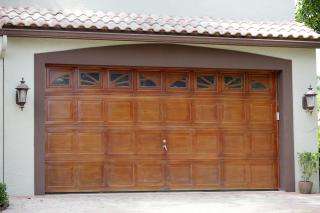
The Olds’ Garage
In 1903, automotive pioneer R.E. Olds built a new home in Lansing, Michigan, and added a 1000-square-foot garage he called an “automobile room”—complete with a turntable structure in the middle, which allowed him to drive onto the structure and then rotate the car, so he would never have to back out of the garage.
Old’s automobile room, considered a luxury only the wealthy would consider building in those days, is now an expected feature of modern day homes, no matter how simple or elaborate the home may be. The design features of overhead doors in Lansing and around the country have moved beyond improved functionality, and are now available in styles that complement the décor of the home.
Clopay Emerges
Clopay Overhead Doors started out as the Bernard Seinsheimer Corporation in 1859, a paper wholesaler in Ohio. Years later, the company started production of blackout shades in response to the atomic threat during WWII, and changed its name to “Clopay.”
- In 1964, Clopay, purchased an established garage door company, Baker-Aldor-Jones. Clopay Overhead Doors manufactured wood doors in those early years, but the company was innovative, and continued to improve the technology while seeking higher quality materials for garage door construction.
- By 1979, 62 percent of homes built in the U.S. were constructed with a two-car garage, and those garages needed durable doors to match the increasingly busy lifestyle of the American family. One year later, Clopay introduced the first steel overhead doors.
Clopay Growth
From its acquisition of Francis Products in 1964, Clopay’s first manufacturing facility, to its purchase of Holmes-Halley Industries in 1997, Clopay has continued to grow and increase its production to now include a 900,000-square-foot manufacturing facility in Troy, OH.
Clopay Innovations

- Polyurethane foam-injected doors for both residential and commercial overhead doors.
- Ultra-Grain paint finish, a stained woodgrain paint finish for steel and aluminum that resembles natural wood
- My-Door, an online tool available for homeowners to visualize how one of the Clopay overhead doors will look on their home. A photo of the homeowner’s current garage is uploaded to the site, and the homeowner can substitute the Clopay overhead door for their current one.
Carriage House Style Returns
Inspired by the early versions of the old carriage houses which were renovated into those early garages, Clopay introduced six different styles of carriage house garage doors, with or without insulation, in steel and composite, or faux wood construction.
Working with a qualified network of garage door installers in Lansing and around the country, Clopay also offers Clopay garage door replacement parts for its installations. For more information about Clopay Overhead Doors, contact a qualified technician at Ingstrup Garage Door and Construction.

